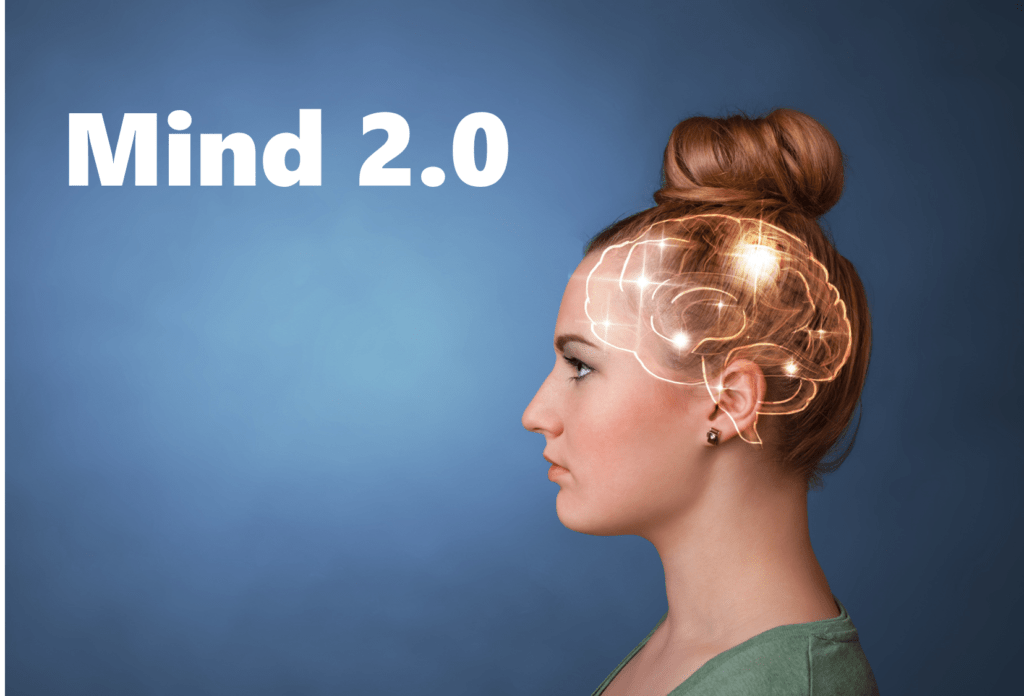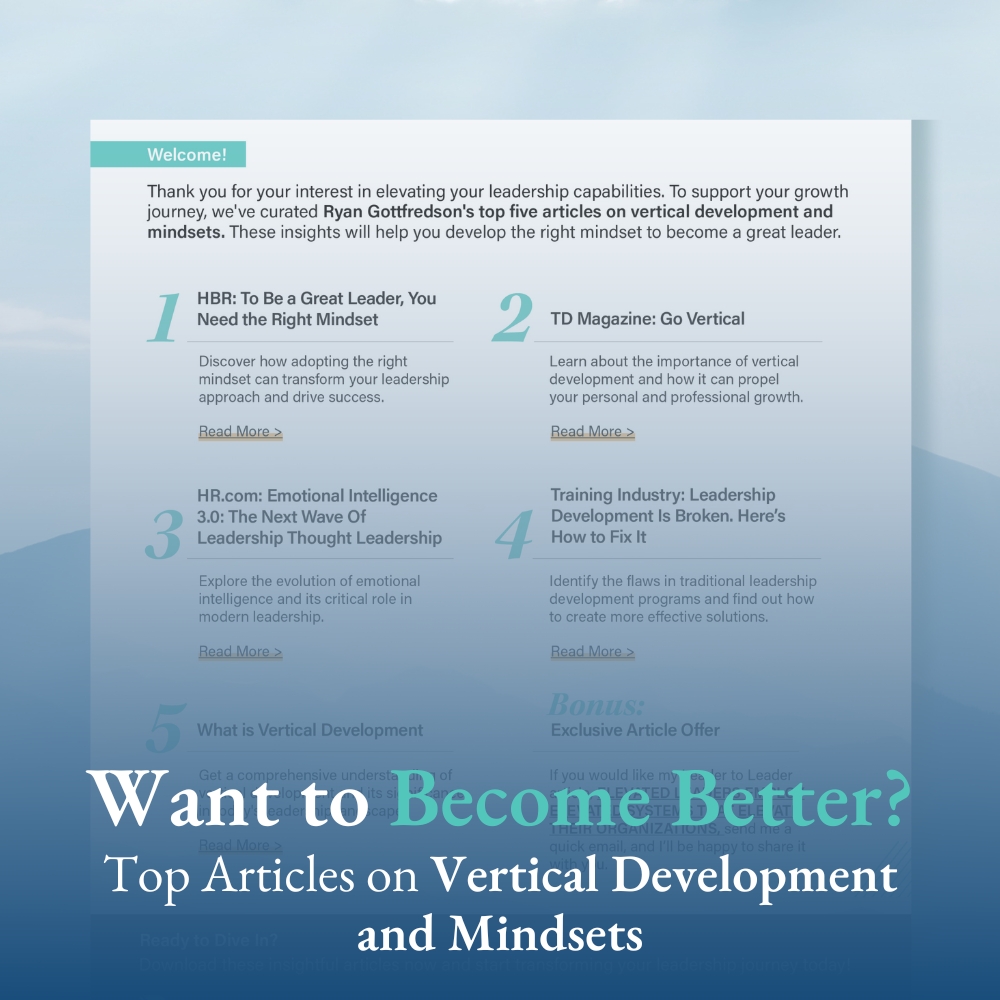Vertical development is a form of development that focuses on upgrading one’s internal operating system (i.e., becoming better). It is all about enhancing one’s ability to make meaning in more cognitively and emotionally sophisticated ways.
50+ years of research and thought-leadership have led to the identification of different levels of cognitive and emotional sophistication that individuals can elevate to.
While there are multiple frameworks identifying various vertical development levels, they all boil down to three levels. I call them:
- Mind 1.0 (64% of all adults and 7% of executives primarily operate at this level)
- Mind 2.0 (35% of all adults and 85% of executives primarily operate at this level)
- Mind 3.0 (1% of all adults and 8% of executives primarily operate at this level)
In my previous article, I went into detail on Mind 1.0, the level most adults primarily operate from.
In this article, I will go into detail on Mind 2.0.
Mind 2.0 – Self-Focused Reward Mode
The internal operating system of Mind 1.0 is programmed to drive the individual to stand in. To stay safe, be comfortable, and belong.
The internal operating system of Mind 2.0 is programmed quite differently. It is programmed to drive the individual to stand out. It drives individuals to focus on getting ahead, advancing, and rising above. They tend to keep score with things like pleasure, wins, gains, results, praise, popularity, power, privilege, and success.
Their biggest fears revolve around being obsolete or redundant; failing, falling short, or losing; and not being seen of value.
When we have the fears and foci identified above, our ultimate and driving focus is on ourselves. We may be slow to see or admit this, but it is true. And, it is why I title Mind 2.0 as “Self-Focused Reward Mode.”
The Hallmark of Mind 2.0 People
Since those in Mind 2.0 are programmed to stand out, they are independent thinkers (Mind 1.0 are dependent thinkers). They don’t instinctively fall in line with their tribes’ beliefs, values, norms, and rules. They are more inclined to question beliefs and authority than Mind 1.0 people, and they develop their own self-governing system (i.e., their own ideology and self-compass). Sometimes their beliefs, values, norms, and rules align with their tribes’, other times they let go of the “shoulds” and “oughts” that were part of their older Mind 1.0 self, and have come up with their own “rights” and “wrongs.” In fact, having different beliefs and values from their tribes helps them stand out.
But, being the creator of their own personal beliefs, values, norms, and rules, they can tend to hold too tightly to them and are reluctant to question them. So, while they are willing to question their tribes’ beliefs, they can be rather closed-minded about their beliefs and stuck thinking inside their own personal box (i.e., they like confirming information but dislike disconfirming information). This rigidity prevents them from fully embracing ambiguity, complexity, and contradiction. It also causes them to be judgmental and critical of others who don’t align with their personal beliefs.
Other Mind 2.0 Characteristics
Being programmed to emphasize standing out and getting ahead, they are inclined to take on the following Mind 2.0 characteristics:
- Focused on hitting immediate short-term goals. Has a hard time seeing the longer-term bigger picture.
- They are initiative-takers.
- They are generally very competitive.
- They are generally focused on effectiveness, efficiency, and productivity.
- They want to take on power and authority because it may be the best way to ensure that they are in control and give them greater ability to be self-directed, take initiative, and stand out (often through hitting goals and being effective, efficient, and productive).
- Although they view themselves as independent and believe that their life is self-authored, because the immediate short-term goals are often defined by others, and because their self-worth comes from standing out in the value they provide, they are generally not aware that they become defined by others.
- The self is more important than the tribe.
- They are willing to be oppositional.
- They have a hard time trusting others beyond themselves (others can slow them down).
- It is important to look good and be right (failing and being wrong means that they won’t stand out or stand out for the wrong reasons).
- Driven to prove themselves.
- Can be rather surface-level and logical thinkers.
- They generally see conflict and negotiations as things to win (another opportunity to prove themselves). They will often seek out conflict as a way to get ahead.
- Only embraces change if they feel it helps them better achieve their goals.
- They like to be in control, and they will often create a box or world around them that they can control. When they do this, they have a hard time seeing outside their box and tend to simplify the world both inside and outside the box. By simplifying they have a hard time understanding, accepting, and appreciating the complexity of their world. When they don’t feel in control, they are susceptible to stress, anxiety, and panic.
- They want the world to mold to them as opposed to them molding to fit the world.
- Often will resist anything that suggests that there is more to life than achievement (or some form of fulfillment or enjoyment)
- Being so focused on outcomes and advancement, they have a hard time being present.
- Being focused on looking good and being right, they have a hard time being vulnerable.
- They will generally only take in feedback or constructive criticism when it comes from a superior and it is delivered in just the right way.
The Dark Side of Mind 2.0
Valuing their independence and standing out through winning and hitting goals, it is easy for those in Mind 2.0 to become wrapped up in looking good, being right, and getting ahead.
There are a lot of upsides to this, such as being successful, hitting metrics, and leading out.
But, there are also some severe downsides. There are two that are most notable.
First, they often see others as objects there to get them where they want to go. Thus, they tend to devalue and use others for their own gains (more to come on this below).
Second, they have a difficult time slowing down and living in the present moment. To them, it often feels like they have lost the “off button.” Being busy, even over-busy, become a key feature of their lives. It can even become a way that they define success. To them, action provides stimulation, excitement, challenge, and satisfaction because action means progress, advancement, and standing out. Unfortunately, it is common for them to have little left in the tank for their primary relationships.
Mind 2.0 Leader
Research has found that nearly all executives operate primarily at this Mind 2.0 level (85%). I would also suspect that the majority of people in leadership positions operate at this level.
Mind 2.0 people are inclined to seek out leadership because, to them, leaders this is the vehicle to obtain attention, status, rewards, and power.
When in a leadership position, they feel more in control of accomplishing the things that they want to accomplish. Liking this control, they are generally like to establish a hierarchical structure and become unwilling to share power. They are inclined to be quite transactional and they have a hard time empowering others.
Being so focused on short-term goals and outcomes, they generally try to simplify their world and lock in on only those things that are directly connected to the goals and outcomes they are seeking to hit. The downside of this is that they generally (1) have a hard time seeing and appreciating complexity, and (2) don’t value or invest in culture. Culture seems like a distraction from “what is really important.”
Being so focused on outcomes and not valuing culture, they are inclined to create a climate that has low psychological safety. This plays out in the following ways:
- They see their employees as objects or tools to get them where they want to go (profits over people)
- They have a strong belief that they are right and thus unwilling to hear the voices of others
- They prefer control over trust
- They are inclined to tell others what to do and are slow to ask questions
- They feel that real conversations slow them down
Summary
Mind 2.0 is the operating system where a large minority of people operate from (35% of all adults) and where nearly all leaders operate from (85% of executives).
While Mind 2.0 people often accomplish great things, their emphasis on themselves and on hitting the outcomes of interest to them, generally has a strong dark side. This dynamic is likely the reason why 75% of employees say that their direct leader is the worst and most stressful part of their job.
Those in Mind 2.0 have what we would classify as a moderate amount of cognitive and emotional sophistication. This is largely because they are independent thinks as opposed to dependent thinkers. But, hopefully, you can clearly see how there is significant room for greater cognitive and emotional sophistication.
I’ll cover Mind 3.0 in the next article.
If you want to learn more about vertical leadership development, please check out my Vertical Leadership Development White Paper.










